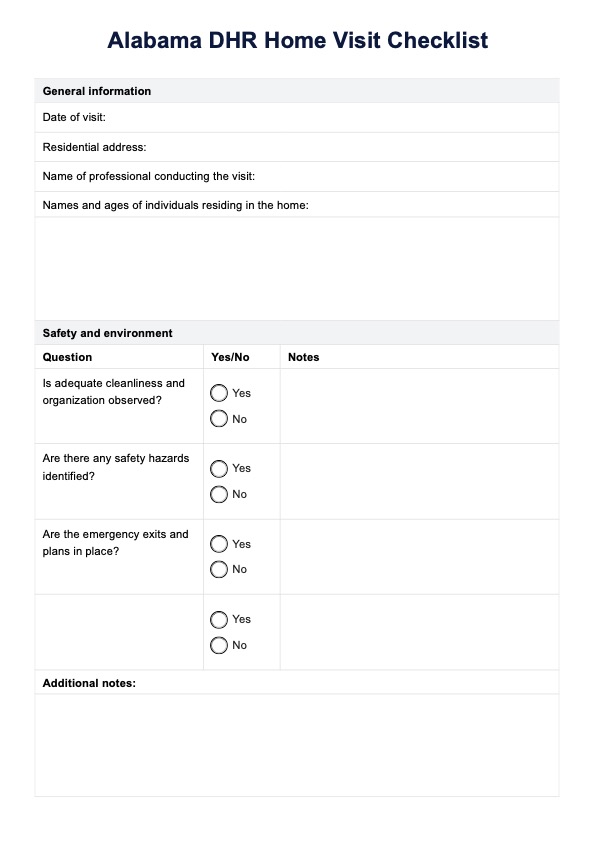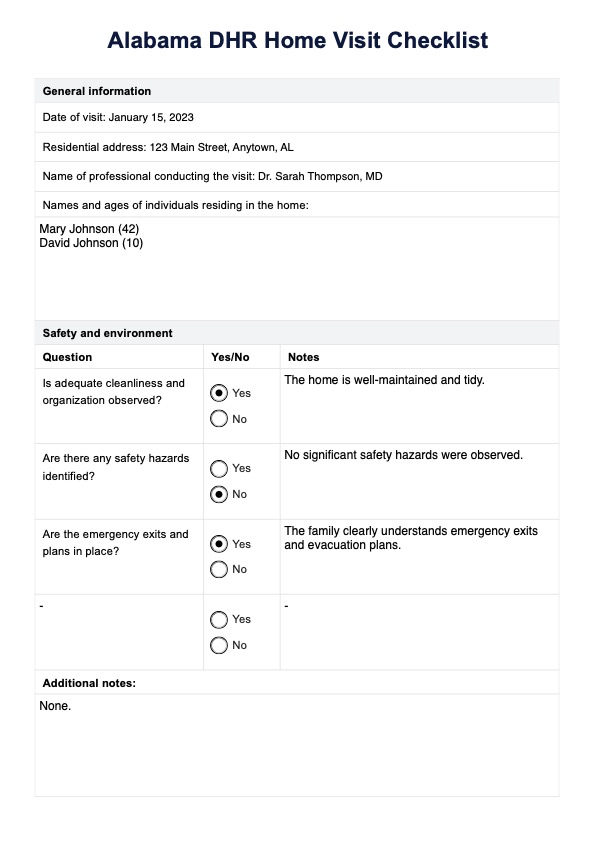Alabama DHR Home Visit Checklist
Download the Alabama DHR Home Visit Checklist template for comprehensive, standardized assessments. Align with state guidelines for effective evaluations.


What is an Alabama DHR Home Visit Checklist?
Healthcare professionals or social workers typically use home visit checklists during a home inspection or an in-home assessment. These assessments may be conducted by government agencies, such as the Alabama Department of Human Resources (DHR), to evaluate the living conditions, safety, and overall well-being of individuals or families.
In the context of healthcare, if one asks, "What does DHR look for in a home visit?" here's a checklist that shows the various aspects they consider:
- Safety and environment: This could involve assessing the cleanliness and safety of the home, checking for potential hazards like fire hazards, and ensuring that the living conditions meet acceptable standards.
- Health and medical needs: Professionals may evaluate the health status of individuals, including any ongoing medical conditions, medication management, and access to necessary healthcare services.
- Nutrition and well-being: The checklist might include questions about the availability and quality of food and the general well-being of individuals in terms of physical and mental health.
- Support systems: Professionals may inquire about the support systems, including family or community support, to determine if the individual or family has the necessary resources for a healthy and stable living environment.
Government agencies, like the Alabama DHR, often conduct home visits to ensure that individuals, especially those in vulnerable situations, receive appropriate care and support. These visits aim to identify issues that may require intervention or assistance, such as neglect, abuse, or inadequate living conditions.
Alabama DHR Home Visit Checklist Template
Alabama DHR Home Visit Checklist Example
How does our checklist work?
The Alabama DHR Home Visit Checklist is a tool professionals use to assess and ensure the well-being of individuals and families in their homes. Here's a breakdown of the steps involved in using or filling out the DHR home inspection checklist (Alabama):
Step 1: Accessing the checklist
Obtain the Alabama DHR Home Visit Checklist PDF by clicking the links or the Download PDF button in this guide.
Step 2: Preparation
Familiarize yourself with the purpose of the checklist and the specific criteria it covers. Gather necessary information and documentation that may be required during the home visit.
Step 3: Scheduling the home visit
Coordinate with the individuals or families to schedule a suitable time for the home visit. Provide advance notice and explain the purpose of the visit to ensure cooperation and transparency.
Step 4: Conducting the home visit
Use the checklist to assess various aspects, including safety, health, nutrition, and support systems. Engage in open communication with the individuals or families to gather additional insights and address concerns.
Step 5: Documenting findings
Record observations and results on the checklist form. Note areas of compliance and any identified issues that may require further attention.
Step 6: Providing feedback
Share feedback with the individuals or families, highlighting both positive aspects and areas for improvement. Discuss any recommended actions or resources that may be beneficial.
Step 7: Follow-up and reporting
Determine the need for follow-up visits based on the initial assessment. Submit a comprehensive report, including the completed checklist, to relevant authorities for further review and decision-making.
When would you use this checklist?
The Alabama DHR Home Visit Checklist is a crucial tool that practitioners should deploy in specific situations to ensure comprehensive assessments and interventions. Here are vital instances when this checklist is particularly valuable:
- Child welfare investigations: During child welfare investigations, social workers can use the checklist to assess the safety and well-being of children, especially younger children, in their homes and evaluate if there's any suspected child abuse. This includes evaluating the environment's cleanliness, potential hazards, and overall suitability for a child.
- Elderly or vulnerable adult assessments: In cases involving elderly individuals or vulnerable adults, healthcare professionals and social workers can employ the checklist to evaluate the living conditions, health management, and support systems. This is crucial for identifying potential neglect, abuse, or inadequate care.
- Post-hospitalization follow-up: After a patient's hospitalization, healthcare professionals can conduct home visits using the checklist to ensure a seamless transition back to their living environment. This includes assessing the home's safety, confirming medication adherence, and addressing post-discharge concerns.
- Chronic disease management: For individuals managing chronic diseases, such as hypertension or diabetes, healthcare practitioners can utilize the checklist to assess the home environment's suitability for effective health management. This includes evaluating nutrition, medication storage, and overall health literacy.
- Community health initiatives: Community health workers can use the checklist in community health initiatives to assess households' overall health and well-being. This is particularly relevant in programs that improve public health, promote healthy lifestyles, and ensure equitable access to healthcare resources.
- Emergency preparedness evaluations: The checklist is invaluable for evaluating home emergency preparedness. This is especially relevant in disaster-prone areas, ensuring that families have adequate plans and resources in place for emergencies.
What do the results mean?
The Alabama DHR Home Visit Checklist documentation significantly affect the individuals or families being assessed and the professionals and agencies involved in their care. Common results and their meanings include:
- Satisfactory compliance: A finding of satisfactory compliance indicates that the assessed individuals or families meet the expected standards in terms of safety, health, and overall well-being. This result is reassuring, suggesting that the living conditions are acceptable and no immediate concerns require intervention. Professionals may provide positive feedback and continue routine monitoring.
- Areas for improvement: If the checklist reveals areas for improvement, it signifies that aspects of the living conditions or support systems may require attention. This could include recommendations for enhancing safety measures, addressing health management issues, or improving the environment. Professionals may work collaboratively with individuals or families to implement necessary changes.
- Safety concerns or hazards: Identification of safety concerns or hazards implies that there are immediate risks to the well-being of the individuals, especially in terms of the physical environment. Professionals must prioritize interventions to mitigate these risks promptly. This may involve collaboration with other agencies, such as child protective services or local health departments, to check for any to ensure the safety of vulnerable individuals, particularly children or elderly adults.
- Health management challenges: If the checklist reveals challenges in health management, such as medication non-compliance or inadequate access to healthcare services, it signals the need for targeted interventions. Healthcare professionals can develop plans to address these challenges, including education, coordination of care, or referrals to specialized services.
- Emergency preparedness awareness: Assessing emergency preparedness may result in findings related to the understanding and readiness of individuals or families in emergencies. Positive results indicate a proactive approach, while gaps may lead to recommendations for creating or enhancing emergency plans.
Commonly asked questions
You can create a checklist using a template from official sources or specialized software such as Carepatron. Customize it to align with Alabama DHR guidelines and specific assessment criteria.
Healthcare professionals, social workers, and government agencies use checklists during in-home assessments. They are employed in child welfare investigations, elder assessments, and post-hospitalization follow-ups.
These checklists systematically evaluate living conditions, safety, health, and support systems during in-home visits. Professionals document observations, identify areas for improvement, and make recommendations based on the checklist results.











































































































